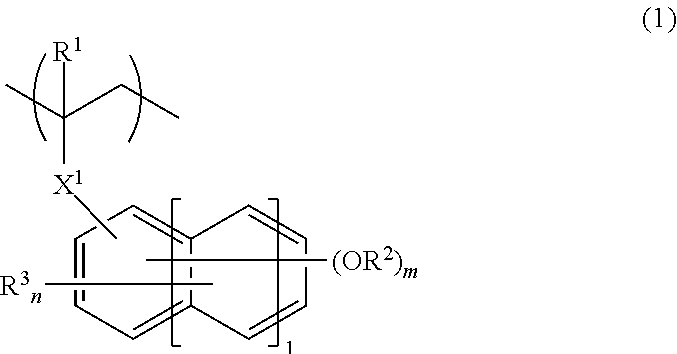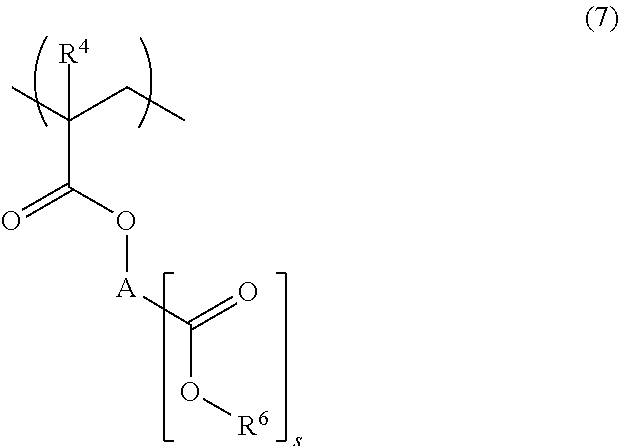Photomask blank, resist pattern forming process, and method for making photomask
a resist pattern and blank technology, applied in the field of photomask blanks, can solve the problems of affecting the accuracy of mask pattern writing, so as to reduce the solubility of alkaline acid, improve efficiency, and improve the effect of accuracy
- Summary
- Abstract
- Description
- Claims
- Application Information
AI Technical Summary
Benefits of technology
Problems solved by technology
Method used
Image
Examples
synthesis example 1
Synthesis of Polymer A1
[0185]In nitrogen atmosphere, 87 g of Monomer 1, 13 g of Monomer 2, and 4.3 g of dimethyl 2,2′-azobisisobutyrate were dissolved in 155 g of a 7 / 3 mixture of methyl ethyl ketone (MEK) and toluene. With stirring at 80° C. in nitrogen atmosphere, the solution was added dropwise to 78 g of a 7 / 3 mixture of MEK and toluene over 4 hours. At the end of dropwise addition, the solution was aged at 80° C. for 2 hours. The polymerization solution was cooled to room temperature and added dropwise to 1,500 g of hexane. The solid precipitate was filtered, washed with 600 g of hexane, and vacuum dried at 60° C. for 20 hours, obtaining a polymer in white powder solid form. The polymer having the following formula is designated Polymer A1. Amount 70 g, yield 70%.
synthesis example 4
Synthesis of Polymer P1
[0187]In nitrogen atmosphere, 890 g of 50.0 wt % PGMEA solution of 4-hydroxystyrene, 47.7 g of acenaphthylene, 169.6 g of 4-(2-hydroxy-2-propyl)styrene, 87.0 g of triphenylsulfonium 1,1,3,3,3-pentafluoro-2-methacryloyloxypropane-1-sulfonate, 96.1 g of dimethyl 2,2′-azobis(2-methylpropionate) (V-601 by Wako Pure Chemical Industries, Ltd.), and 360 g of γ-butyrolactone and 220 g of PGMEA as solvent were fed into a 3000-mL dropping cylinder to form a monomer solution. In nitrogen atmosphere, a 5000-mL polymerization flask was charged with 580 g of γ-butyrolactone, which was heated at 80° C. The monomer solution was added dropwise from the dropping funnel to the flask over 4 hours. After the completion of dropwise addition, the polymerization solution was continuously stirred for 18 hours while maintaining its temperature at 80° C. The polymerization solution was cooled to room temperature and added dropwise to 22.5 kg of diisopropyl ether whereupon the copolymer ...
synthesis example 5
Synthesis of Polymer B1
[0188]In nitrogen atmosphere, 39.26 g of 4-acetoxystyrene, 6.14 g of acenaphthylene, 19.6 g of 4-(2-hydroxy-2-propyl)-styrene, 7.43 g of dimethyl 2,2′-azobis(2-methylpropionate) (V-601 by Wako Pure Chemical Industries, Ltd.), and 90 g of MEK as solvent were fed into a 200-mL dropping cylinder to form a monomer solution. In nitrogen atmosphere, a 500-mL polymerization flask was charged with 60 g of MEK, which was heated at 80° C. The monomer solution was added dropwise from the dropping funnel to the flask over 4 hours. After the completion of dropwise addition, the polymerization solution was continuously stirred for 18 hours while maintaining its temperature at 80° C. The polymerization solution was cooled to room temperature and added dropwise to 1,000 g of hexane whereupon the copolymer precipitated. The copolymer precipitate was collected by filtration and washed twice with 200 g of hexane. In a 1-L flask under nitrogen atmosphere, the copolymer was dissol...
PUM
| Property | Measurement | Unit |
|---|---|---|
| size | aaaaa | aaaaa |
| thickness | aaaaa | aaaaa |
| thickness | aaaaa | aaaaa |
Abstract
Description
Claims
Application Information
 Login to View More
Login to View More - R&D
- Intellectual Property
- Life Sciences
- Materials
- Tech Scout
- Unparalleled Data Quality
- Higher Quality Content
- 60% Fewer Hallucinations
Browse by: Latest US Patents, China's latest patents, Technical Efficacy Thesaurus, Application Domain, Technology Topic, Popular Technical Reports.
© 2025 PatSnap. All rights reserved.Legal|Privacy policy|Modern Slavery Act Transparency Statement|Sitemap|About US| Contact US: help@patsnap.com



